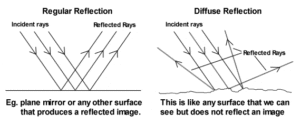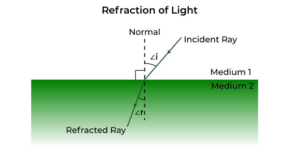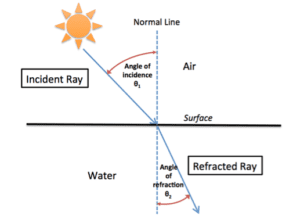Mirrors are objects that reflect almost all of the light that falls on them. There are two main types of mirrors: flat mirrors, also known as plane mirrors, and curved mirrors, also known as spherical mirrors.
This article focuses on two specific types of spherical mirrors: convex mirrors and concave mirrors. By using ray diagrams, we can better understand how light behaves when it comes into contact with these mirrors. The ray diagrams of spherical mirrors allow us to understand the fascinating phenomena of reflection and image formation.
What is a plane mirror?

A plane mirror is a type of mirror that has a flat surface and reflects light predictably. It is one of the simplest and most common types of mirrors used in everyday life. When light rays strike a plane mirror, they bounce off the mirror’s surface and form a reflected image.
Characteristics and properties of plane mirrors
Here’s a detailed explanation of the characteristics and properties of plane mirrors:

- Flat Surface: A plane mirror consists of a flat, smooth surface made from materials such as glass or metal. The surface is usually coated with a thin layer of reflective material, such as aluminum or silver, to create the mirror effect.
- Reflection: The primary characteristic of a plane mirror is that it reflects light according to the law of reflection. The law of reflection states that the angle of incidence (the angle between the incident ray and the mirror surface) equals the angle of reflection (the angle between the reflected ray and the mirror surface). In other words, the angle at which light strikes the mirror is the same as the angle at which it bounces off.
- Virtual Images: When light rays reflect off a plane mirror, they create an image. However, the image formed by a plane mirror is virtual. A virtual image is an image that appears to be behind the mirror as if it were a reflection of an object located behind the mirror’s surface. This differs from a real image, which can be formed by curved mirrors and projected onto a screen.
- Laterally Inverted: Another property of a plane mirror is that it produces a laterally inverted image. This means that the object’s left side appears on the right side in the mirror image, and vice versa. For example, if you hold a book in front of a plane mirror, the wording on the book will appear reversed in the mirror image.
- Size and Distance: Plane mirrors do not change the size or distance of the objects being reflected. The image formed by a plane mirror is said to be “equal-sized” because it has the same dimensions as the object being reflected. Additionally, the distance between the object and the mirror is the same as between the mirror and the image.
- Multiple Reflections: Plane mirrors can be used to create multiple reflections. When two or more plane mirrors are positioned at different angles to each other, they can reflect light in a way that creates a series of reflections. This effect is often used in optical illusions and kaleidoscopes.
- Applications: Plane mirrors have various practical applications in everyday life. They are used in mirrors for personal grooming, decorative mirrors, rear-view mirrors in vehicles, and many other applications where a clear, undistorted reflection is required.
Plane mirrors vs spherical mirrors
There are some basic differences between plane mirrors and spherical mirrors. Here is a comparison and contrast between plane mirrors and spherical mirrors:

Shape and Surface
The primary difference between plane mirrors and spherical mirrors lies in their shape and surface curvature.
- Plane Mirror: A plane mirror has a flat surface. The reflective coating is applied directly to a flat glass or metal surface, resulting in a mirror that reflects light uniformly and without distortion. The reflection occurs at the same angle as the incidence, following the law of reflection.
- Spherical Mirror: A spherical mirror, on the other hand, has a curved surface that forms a portion of a sphere. There are two types of spherical mirrors: concave mirrors and convex mirrors.
Curvature and Focal Point
- Concave Mirror: A concave mirror curves inward, meaning that the reflective surface is on the inner side of the curved shape. The center of curvature (C) lies on the same side as the reflective surface. The focal point (F) is located along the principal axis, halfway between the center of curvature and the mirror’s surface. Light rays parallel to the principal axis converge at the focal point after reflection.
- Convex Mirror: A convex mirror curves outward, with the reflective surface on the outer side of the curved shape. The center of curvature (C) is located on the opposite side of the reflective surface. The focal point (F) for a convex mirror is located behind the mirror, as if the reflected rays were diverging from that point. However, for practical purposes, the focal point is considered virtual.
Image Formation
- Plane Mirror: A plane mirror forms a virtual image, which appears to be located behind the mirror’s surface. The image is laterally inverted, meaning that the left and right sides are swapped. The size of the image is the same as that of the object being reflected.
- Spherical Mirror: The image formed by a spherical mirror depends on the type of mirror and the position of the object.
- Concave Mirror: When the object is placed beyond the focal point, a real inverted image is formed between the focal point and the center of curvature. When the object is placed between the focal point and the mirror’s surface, a virtual and magnified image is formed. The virtual image is upright and on the same side as the object.
- Convex Mirror: Convex mirrors always form virtual, diminished, and upright images. The image is formed on the same side as the object and appears smaller than the object.
Applications
- Plane mirrors find usage in everyday applications such as personal grooming mirrors, decorative mirrors, and rear-view mirrors in vehicles.
- Concave mirrors are commonly utilized in applications where focusing or magnification is required, such as reflecting telescopes, makeup mirrors, and headlights.
- Convex mirrors are commonly used as safety mirrors in parking lots, road intersections, and store aisles to provide a wider field of view and reduce blind spots.
Read Also
- Gauss law for magnetism class 12 | statement, derivation, differential form, and integral form
- Gauss’s Law – gauss’s law in integral form, gauss’s law in differential form
- Electric Charges, types, units, and properties
- Superposition principle | electric field due to system of Charges.
Characteristics of Concave and Convex Mirrors
Concave mirror definition
Concave Mirror Definition: A concave mirror is a type of spherical mirror with a curved reflective surface that curves inward. It converges light rays that are initially parallel to the mirror’s principal axis to a focal point. It can form real or virtual images, depending on the position of the object relative to the mirror. Concave mirrors are commonly used in applications requiring focusing, magnification, or the reflection of light.
Characteristics of Concave Mirrors

- Curvature: Concave mirrors have a curved reflective surface that curves inward. The surface is shaped like a section of the inner surface of a hollow sphere.
- Focal Point: Concave mirrors have a focal point (F) located along the principal axis. The focal point is the point where light rays that are initially parallel to the principal axis converge after reflection.
- Center of Curvature: The center of curvature (C) of a concave mirror is the center of the sphere from which the mirror section is derived. It lies on the same axis as the mirror, opposite the reflective surface.
- Principal Axis: The principal axis is an imaginary line passing through the center of curvature (C) and the midpoint of the mirror. Light rays that strike the mirror parallel to the principal axis converge or diverge based on their position relative to the focal point.
- Image Formation: The position and characteristics of the image formed by a concave mirror depend on the position of the object relative to the mirror.
- An object beyond the focal point: When the object is positioned beyond the focal point, the image formed by a concave mirror is real, inverted, and located between the focal point and the center of curvature.
- Object at the focal point: If the object is placed precisely at the focal point, the reflected rays become parallel to each other, resulting in no distinct image formation.
- Object between the focal point and the mirror: When the object is between the focal point and the mirror’s surface, the image formed is virtual, upright, and magnified. The image appears to be on the same side as the object.
6. Magnification: Concave mirrors can produce magnified or diminished images depending on the relative positions of the object, focal point, and mirror. The magnification factor determines the size of the image compared to the object.
7. Applications: Due to their ability to converge light rays, concave mirrors have various practical applications. They are commonly used in telescopes, satellite dishes, searchlights, and headlights to focus and direct light. Concave mirrors are also used in shaving and makeup mirrors to produce magnified images.
Convex Mirror Definition
Convex Mirror Definition: A convex mirror is a type of spherical mirror with a curved reflective surface that curves outward. It forms virtual, upright, and diminished images. Convex mirrors are commonly used for their wide field of view and reduction of blind spots in applications such as rear-view mirrors and safety mirrors.
Characteristics of Convex Mirrors

- Curvature: Convex mirrors have a curved reflective surface that curves outward. The surface is shaped like a section of the outer surface of a hollow sphere.
- Focal Point: Convex mirrors have a focal point (F) located behind the mirror. The focal point is considered virtual and does not physically exist.
- Center of Curvature: The center of curvature (C) of a convex mirror is located on the opposite side of the reflective surface. It lies on the same axis as the mirror.
- Image Formation: When an object is placed in front of a convex mirror, the mirror reflects the incoming light rays. The resulting image formed by a convex mirror is always virtual, upright, and diminished (smaller in size than the object). The image appears to be located behind the mirror.
- Field of View: Convex mirrors provide a wider field of view compared to other types of mirrors. Due to their outward curvature, they can reflect a larger area of the scene. This makes convex mirrors useful in applications where a broad view or monitoring of a wide area is required.
- Reduction of Blind Spots: The curved surface of convex mirrors allows for a wider viewing angle, reducing blind spots. This is particularly helpful in situations where visibility is crucial, such as when driving a vehicle or observing traffic in congested areas.
- Image Distortion: Convex mirrors produce a distorted image compared to the actual object. The distortion is due to the way light rays diverge after reflection. Objects near the edges of the mirror appear more stretched or elongated compared to their actual shape.
- Applications: Convex mirrors have practical applications in various fields. They are commonly used as safety mirrors in parking lots, road intersections, and store aisles to provide a wider field of view and reduce blind spots. Convex mirrors are also used in decorative applications due to their unique shape and visual properties.
Image Formation by Spherical Mirrors
To create accurate ray diagrams and gain a better understanding of image formation, it is essential to be aware of the guidelines for ray incidence on concave and convex mirrors. By analyzing the behavior of light rays, we can confidently predict their movements and accurately draw a ray diagram to represent the image formation.
Rules for drawing ray diagrams for Concave and Convex Mirrors
Drawing ray diagrams for concave and convex mirrors is a helpful visual representation to understand how light rays interact with these mirrors and form images. Here are the rules for drawing ray diagrams for both concave and convex mirrors:
Ray Diagram Rules for Concave Mirrors:
- Parallel Ray Rule: A ray parallel to the principal axis, upon striking a concave mirror, reflects through the focal point (F). This helps in determining the location of the reflected rays.
- Focal Point Ray Rule: A ray directed towards the focal point (F) of the concave mirror reflects parallel to the principal axis after reflection.
- Center of Curvature Ray Rule: A ray directed towards the concave mirror’s center of curvature (C) reflects along the same path.
- Vertex Ray Rule: If the ray is directed at the vertex, then the ray is reflected, following the laws of reflection.
- Combined Ray Paths: The point where these reflected rays intersect is the location of the image formed by the concave mirror. If the rays converge on the same side as the incident rays, the image is real. If extended backward, they converge on the opposite side, forming a virtual image.
Ray Diagrams rules for Convex Mirrors

- Parallel Ray Rule: A ray parallel to the principal axis, when striking a convex mirror, appears to diverge as if coming from the virtual focal point (F) behind the mirror.
- Focal Point Ray Rule: A ray directed towards the focal point (F) of the convex mirror reflects parallel to the principal axis after reflection.
- Center of Curvature Ray Rule: A ray directed towards the center of curvature (C) of the convex mirror reflects along the same path.
- Vertex Ray Rule: If the ray is directed at the vertex, then the ray is reflected, following the laws of reflection.
- Combined Ray Paths: Similar to concave mirrors, the intersection point of these reflected rays determines the location of the image formed by the convex mirror. However, in the case of convex mirrors, the image is always virtual and upright.
Ray diagrams provide a graphical representation of the behavior of light rays and help in understanding the formation of images by spherical mirrors.
Read More
- Derive relation between focal length and radius of curvature
- Cartesian sign convention for spherical mirrors
- Laws of Reflection of Light class 12
Image Formation by Concave Mirror
The image formation of a concave mirror varies depending on the position of the object along the principal axis. Here’s an explanation of how the image is formed at different positions of the object.
Object at Infinity

- Position of Object (O): Infinitely far away from the concave mirror.
- Image Characteristics:
- Real and inverted.
- Formed at the focal point (F) of the concave mirror.
- The image is highly focused and is a point of light.
- Ray Diagram:
- A set of parallel rays from the object at infinity is directed towards the concave mirror.
- These parallel rays are then reflected and converge at the focal point (F) on the principal axis.
- The image is formed at the focal point, and it is a real and inverted point-like image.
Object Beyond the Center of Curvature (C)

- Position of Object (O): Beyond the Center of Curvature (C).
- Image Characteristics:
- Real and inverted.
- Smaller in size.
- Formed between the focal point (F) and the center of curvature (C).
- Ray Diagram:
- A parallel ray from the object reflects through F.
- A ray directed towards F reflects parallel to the principal axis.
- A ray towards C reflects back on itself.
- The intersection of these rays forms the real and inverted image between F and C.
Object at the Center of Curvature (C)

- Position of Object (O): At the Center of Curvature (C).
- Image Characteristics:
- Real and inverted.
- Same size as the object.
- Formed exactly at the center of curvature.
- Ray Diagram:
- A parallel ray reflects through F.
- A ray directed towards F reflects parallel to the principal axis.
- A ray towards C reflects back on itself.
- The intersection of these rays forms the real and inverted image precisely at the center of curvature.
Object Between the Center of Curvature (C) and the Focal Point (F)

- Position of Object (O): Between C and F.
- Image Characteristics:
- Real and inverted.
- Enlarged in size.
- Formed beyond the center of curvature (C).
- Ray Diagram:
- A parallel ray reflects through F.
- A ray directed towards F reflects parallel to the principal axis.
- A ray towards C reflects back on itself.
- The intersection of these rays forms the real and inverted image beyond C.
Object at the Focal Point (F)
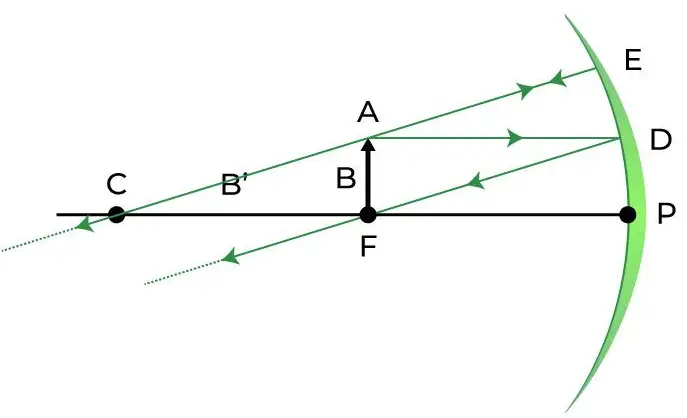
- Position of Object (O): At the focal point (F).
- Image Characteristics:
- No real image was formed.
- Rays of light are parallel after reflection.
- It appears as if the rays are coming from infinity.
- Ray Diagram:
- Parallel rays are reflected as if they are coming from F, but they do not converge.
- No real image is formed; the reflected rays diverge.
Object Between the Focal Point (F) and the Mirror

- Position of Object (O): Between F and the mirror.
- Image Characteristics:
- Virtual and erect.
- Enlarged in size.
- Formed on the same side as the object.
- Ray Diagram:
- A parallel ray reflects through F.
- A ray directed towards F reflects parallel to the principal axis.
- A ray towards C reflects back on itself.
- The intersection of these rays forms a virtual and erect image on the same side as the object.
Summary of image formation by concave mirror
| Object Position | Image Characteristics | Image Position |
|---|---|---|
| Beyond C | Real, Inverted, and Smaller | Between F and C |
| At C | Real, Inverted, Same Size | At C |
| Between C and F | Real, Inverted, and Enlarged | Beyond C |
| At F | No Real Image | No real image (Diverging Rays) |
| Between F and Mirror | Virtual, Erect, and Enlarged | Beyond F (Same Side as Object) |
| At Infinity | Real, Inverted, and Point-like (Focal Point) | At F (Focal Point), |
Read More:
- Behaviour of light at the interface of two media
- Cartesian sign convention for spherical mirrors
- Optics: definition, types, and applications, class 12
- Simple microscope Class 12, Definition, Magnification, working, Parts And Uses
- Reflection of light class 12: definition and types
- Spherical mirrors: definition, types, and terminologies
Image Formation by Convex Mirror
The image formation of a convex mirror is distinct from that of a concave mirror. Here’s an explanation of how the image is formed at different positions of the object along the principal axis of a convex mirror.
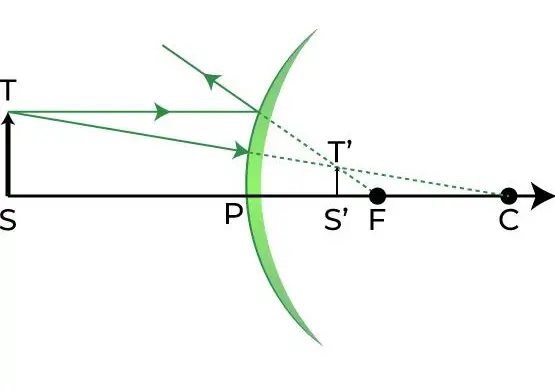
Object Beyond the Center of Curvature (C)
- Position of Object (O): Beyond the Center of Curvature (C).
- Image Characteristics:
- Virtual and erect.
- Smaller in size.
- Formed between the focal point (F) and the mirror.
- Ray Diagram:
- Parallel rays from the object reflect divergently, making it seem as if they originate from the virtual focal point (F) behind the mirror.
- The extended reflected rays appear to converge behind the mirror, forming a virtual and erect image between F and the mirror.
Object at the Center of Curvature (C)
- Position of Object (O): At the Center of Curvature (C).
- Image Characteristics:
- Virtual and erect.
- Same size as the object.
- Formed at the center of curvature.
- Ray Diagram:
- Parallel rays from the object reflect divergently, making it appear as if they come from the virtual focal point (F) behind the mirror.
- The extended reflected rays appear to converge at the center of curvature (C), forming a virtual and erect image at C.
Object Between the Center of Curvature (C) and the Focal Point (F)
- Position of Object (O): Between C and F.
- Image Characteristics:
- Virtual and erect.
- Enlarged in size.
- Formed beyond the center of curvature (C).
- Ray Diagram:
- Parallel rays from the object reflect divergently, making it seem as if they originate from the virtual focal point (F) behind the mirror.
- The extended reflected rays appear to converge farther away from the mirror, forming a virtual and erect image beyond C.
Object at the Focal Point (F)
- Position of Object (O): At the focal point (F).
- Image Characteristics:
- No real image was formed.
- Rays of light are reflected in parallel after reflection.
- It appears as if the rays are coming from infinity.
- Ray Diagram:
- Parallel rays from the object reflect divergently, making it appear as if they come from the virtual focal point (F) behind the mirror.
- The extended reflected rays appear parallel, and no real image is formed.
Object Between the Focal Point (F) and the Mirror
- Position of Object (O): Between F and the mirror.
- Image Characteristics:
- Virtual and erect.
- Enlarged in size.
- Formed on the same side as the object.
- Ray Diagram:
- Parallel rays from the object reflect divergently, making it seem as if they originate from the virtual focal point (F) behind the mirror.
- The extended reflected rays appear to converge closer to the mirror, forming a virtual and erect image on the same side as the object.
Object at Infinity

- Position of Object (O): Infinitely far away from the convex mirror.
- Image Characteristics:
- Virtual and erect.
- Smaller in size.
- Formed between the focal point (F) and the mirror.
- Ray Diagram:
- Parallel rays from the object reflect divergently, making it seem as if they originate from the virtual focal point (F) behind the mirror.
- The extended reflected rays appear to converge to the focus point, forming a virtual, highly diminished, and erect image at F behind the mirror.
Summary of image formation by convex mirror
| Object Position | Image Characteristics | Image Position |
|---|---|---|
| Beyond C | Virtual, Erect, and Smaller | Between F and C |
| At C | Virtual, Erect, Same Size | At C |
| Between C and F | Virtual, Erect, and Enlarged | Beyond C |
| At F | No Real Image | No real image (Diverging Rays) |
| Between F and Mirror | Virtual, Erect, and Enlarged | Same side as the object |
| At Infinity | Virtual, Erect, and Point-size | At F behind the mirror |
Read Also
- Faraday and henry’s experiments on electromagnetic induction
- Faraday’s laws of electromagnetic induction Class 12
- Displacement current class 12: definition, modification, formula, and properties
- Electromagnetic induction | definition, applications, and history
- Magnetic flux – definition, formula, units, and dimensions
Frequently Asked Questions (FAQs)
What is the difference between a concave mirror and a convex mirror?
Concave mirrors have a curved reflective surface that curves inward, while convex mirrors have a curved reflective surface that curves outward.
How does a concave mirror form an image?
A concave mirror forms an image by reflecting light rays. The position and characteristics of the image depend on the location of the object relative to the mirror.
What is the focal point of a concave mirror?
The focal point of a concave mirror is the point where light rays that are initially parallel to the mirror’s principal axis converge after reflection.
Can a convex mirror form a real image?
No, a convex mirror cannot form a real image. It always forms a virtual image that is upright, diminished, and located behind the mirror.
Why are convex mirrors used as rear-view mirrors in vehicles?
Convex mirrors provide a wider field of view, allowing drivers to see a larger area and reducing blind spots.
How does the image formed by a convex mirror differ from the actual object?
The image formed by a convex mirror is always smaller, virtual, and upright compared to the actual object. It also appears to be located behind the mirror.
What is the center of curvature of a spherical mirror?
The center of curvature of a spherical mirror is the center of the sphere from which the mirror section is derived. It lies on the same axis as the mirror, opposite the reflective surface.
What are some practical applications of concave mirrors?
Concave mirrors are used in telescopes, satellite dishes, searchlights, and headlights for focusing and directing light. They are also used in shaving and makeup mirrors to produce magnified images.
How does the size of the image formed by a concave mirror change with the object’s position?
When the object is placed beyond the focal point of a concave mirror, the image is smaller than the object. When the object is between the focal point and the mirror’s surface, the image is magnified and larger than the object.
Can convex mirrors produce distorted images?
Yes, convex mirrors can produce distorted images. Objects near the edges of the mirror may appear elongated or stretched compared to their actual shape.
Stay tuned with Laws Of Nature for more useful and interesting content.





